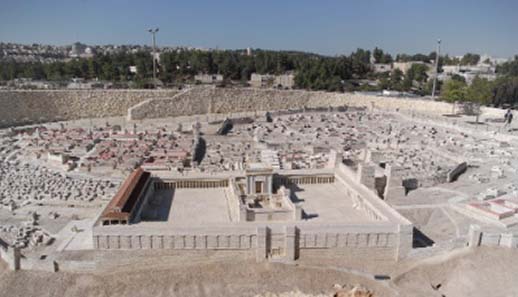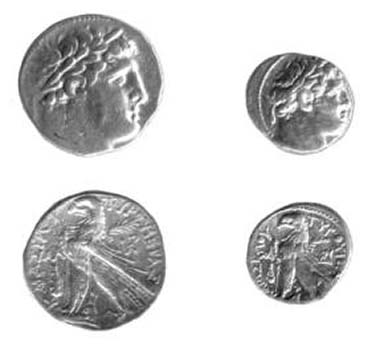by David Hendin
Officials called for the annual Temple contribution at the beginning of the Hebrew month of Adar, preceding Passover, so that by the first day of the Hebrew month of Nissan, with the start of the Temple’s year, contributions could be used for the daily offerings. Surplus funds were transferred for use for other Temple needs.
A model of Herod’s Temple, The Israel Museum / Jerusalem. Source: Berthold Werner / Wikipedia.
On the fifteenth day of Adar, money-changing tables were set up throughout the country to receive the annual tribute. Talmudic traditions mention various cities in Galilee where lists were gathered and transferred to Jerusalem. After 10 days, on the twenty-fifth of Adar, the money-changers terminated their local collections and continued their operations only in the Jerusalem Temple.
Virtually all Jews, including those who had expressed reservations about the current state of the Temple and its system of sacrifices, also sent their contributions to the Temple. Matthew 17:24-27 tells the story of how Jesus and his disciples were solicited and gave their contribution to the collectors of the Temple tribute:
“And when they were come to Capernaum, they that received tribute money came to Peter, and said, Doth not your master pay tribute? He saith, Yes. And when he was come into the house, Jesus prevented him, saying, What thinkest thou, Simon? of whom do the kings of the earth take custom or tribute? of their own children, or of strangers? Peter saith unto him, Of strangers. Jesus saith unto him, Then are the children free. Notwithstanding, lest we should offend them, go to the sea, and cast a hook, and take up the fish that first cometh up; and when thou hast opened his mouth, thou shalt find a piece of money: that take, and give unto them for me and thee.”
This story of the coin in the fish’s mouth is never further verified beyond this telling – in other words, we don’t know if a coin was actually found there. If it was, however, it seems clear from Matthew’s report that it was a shekel of Tyre since it was supposed to pay the annual half-shekel Temple tribute for both Jesus and for Peter the fisherman.
Recent Tyre Silver Hoard
American and European dealers have recently offered Tyre shekels (tetradrachms) and half shekels (didrachms) from a large hoard that was apparently discovered relatively recently in the area that made up ancient Phoenicia.
Tyre shekel dated 96/95 BCE (left) and half shekel dated 90/89 BCE from the group that recently appeared on the market.
I examined a few hundred of the coins and they dated mostly to the early first century B.C.E. The coins were beautifully struck and in strong condition. The silver of many of them was slightly grainy or uneven, but the weights were strong, with most shekels near 14 grams and most half shekels near 7 grams.
This large group served as a bit of a reminder for me that the shekels and half shekels of Tyre (together with some Seleucid tetradrachms and didrachms often struck in Tyre, Sidon, or Antioch) were certainly the most commonly circulated silver coins in the ancient Holy Land from the first century B.C.E. to the time of the Jewish War Against Rome, which ended in 70 C.E.
It is also known, as discussed above, that during that period, these coins were the only coins accepted as payment of the annual tribute to the Jerusalem Temple of one half shekel per Jewish adult male.
Ya’akov Meshorer theorizes that there were two basic issues of Tyrian silver coins. The first issue was struck in Tyre from 126/5 B.C.E. until 19/18 B.C.E. and the second issue was struck in or near Jerusalem, from 18/17 B.C.E. until 69/70 C.E. This is possible, though other numismatists have argued that the second issue, which is cruder in style and manufacture than the first, may not have been minted at Tyre, but was probably minted somewhere other than Jerusalem.
Whether struck in Tyre or farther south, it is clear that the silver coins of ancient Tyre were well known in the ancient world for their weight and quality of silver. The Talmud states that “Silver, whenever mentioned in the Pentateuch, is Tyrian silver.” (Tosephta Kethuboth 13,20)
Because of this quotation, backed up by the obviously large quantity of the coins originally minted, it is quite clear that many New Testament stories, such as the coin in the fish’s mouth mentioned above, the 30 pieces of silver paid to Judas for his betrayal of Jesus, and the large silver coins used to bribe the soldiers who had fled from their watch at the Holy Sepulchre on Easter morning … all involved the shekels and the half shekels of Tyre.
by courtesy of David Hendin, Copyright by David Hendin, all rights reserved.
If you want to know more about David Hendin, specialist for Jewish coin, please visit his website and click here.







